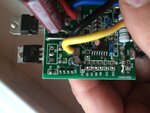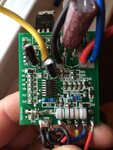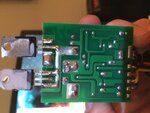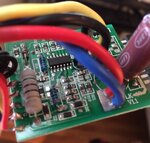mvoltin
Junior Member level 1
Need an advice to prevent the MOSFET from blowing up on a motor controller. Below is more info with little background:
After spending days reading online about different controller designs, I have given up the aspiration of figuring out how these things work. Just trying to get a scooter working so that my kids can ride it and be done with it. This is for a scooter with 250watt motor and the controller is a Chinese cheap stuff with variable throttle from a hall effect sensor. My 10 year old was driving it uphill and that is when it busted (MOSFET is blown and it is on full power all the time). I am getting a replacement controller but it would be dangerous if this happened again and kids having no way to stop the scooter.
Controller is supposed to be a current limiting to ~10amps (250watt and 24v) but I suspect the motor was drawing too much current on uphill and the current limiting feature did not work. (P.S. I ruled out motor running as a generator and sending current back to the controller as the cause since 1) it was during an uphill and 2) motor does not turn when the scooter is rolling, the chain can only "pull").
Right now, I am trying to figure out if, once i get a replacement, I can add some diode or something else to the controller to help prevent this from happening. Attached is the picture and partial diagram (only parts close to the MOSFET) since the overall controller is too complicated for me to draw. Couple clarifications about the diagram picture:
The drawing tool had limited library and the following components are substituted:
1) the NPN transistor on the schematic is actually a Schottky Rectifier - stps2045ct
2) Mosfet is 75NF75b
3) the two diodes on the left are actually 3 pin diodes BZX84C12V
4) and there is an IC:"339 st gz1k338" on the board that I think is a Low-power quad voltage comparator LM339
I know this is a very limited info but is there anything I can add/solder to this board that would prevent the MOSFET from blowing because of the high current?
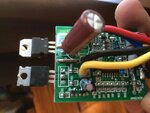

After spending days reading online about different controller designs, I have given up the aspiration of figuring out how these things work. Just trying to get a scooter working so that my kids can ride it and be done with it. This is for a scooter with 250watt motor and the controller is a Chinese cheap stuff with variable throttle from a hall effect sensor. My 10 year old was driving it uphill and that is when it busted (MOSFET is blown and it is on full power all the time). I am getting a replacement controller but it would be dangerous if this happened again and kids having no way to stop the scooter.
Controller is supposed to be a current limiting to ~10amps (250watt and 24v) but I suspect the motor was drawing too much current on uphill and the current limiting feature did not work. (P.S. I ruled out motor running as a generator and sending current back to the controller as the cause since 1) it was during an uphill and 2) motor does not turn when the scooter is rolling, the chain can only "pull").
Right now, I am trying to figure out if, once i get a replacement, I can add some diode or something else to the controller to help prevent this from happening. Attached is the picture and partial diagram (only parts close to the MOSFET) since the overall controller is too complicated for me to draw. Couple clarifications about the diagram picture:
The drawing tool had limited library and the following components are substituted:
1) the NPN transistor on the schematic is actually a Schottky Rectifier - stps2045ct
2) Mosfet is 75NF75b
3) the two diodes on the left are actually 3 pin diodes BZX84C12V
4) and there is an IC:"339 st gz1k338" on the board that I think is a Low-power quad voltage comparator LM339
I know this is a very limited info but is there anything I can add/solder to this board that would prevent the MOSFET from blowing because of the high current?


